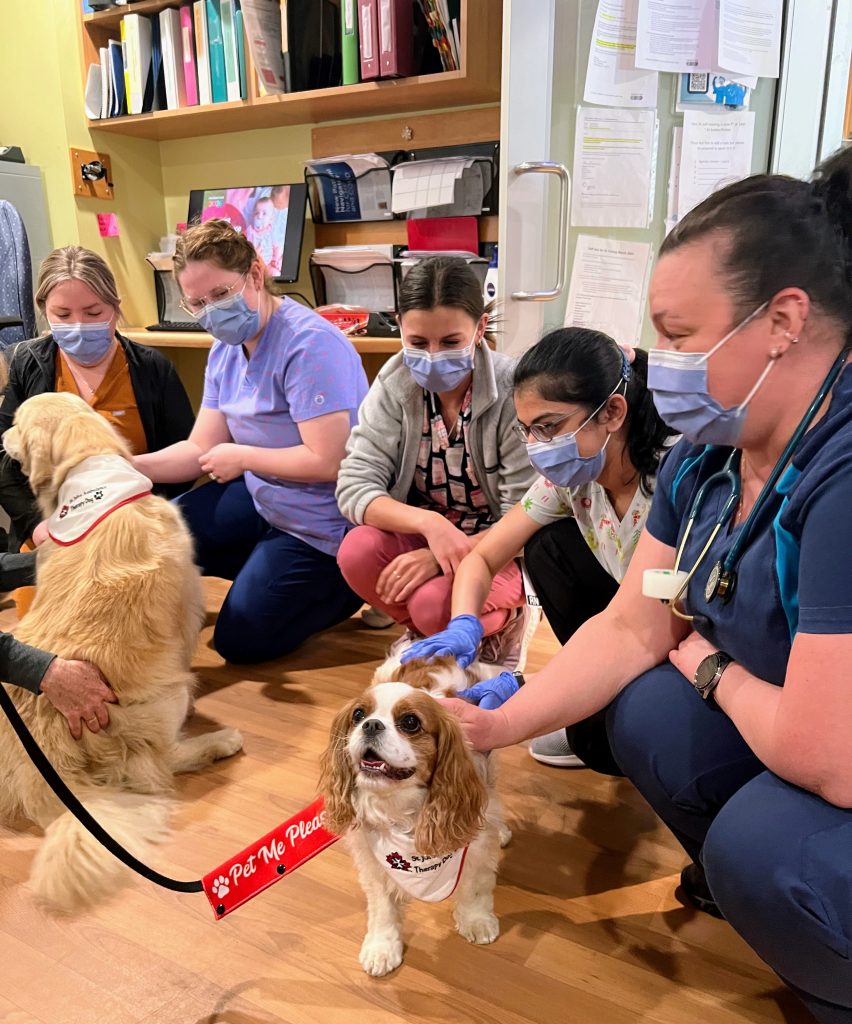Paws and Relax: Therapy Dogs for Hospital Staff
by Caitlund Davidson
 In May 2023, the Thunder Bay Regional Health Sciences Centre, in collaboration with St. John Ambulance, launched a therapy dog program for its staff.
In May 2023, the Thunder Bay Regional Health Sciences Centre, in collaboration with St. John Ambulance, launched a therapy dog program for its staff.Originally published in the July 2023 edition of the Walleye Magazine
Pets serve a great purpose in our daily lives. In addition to being our furry friends, some are trained to perform specific duties. Therapy dogs undergo an extensive evaluation process to become certified and take on unique roles. Through petting, affection, and regular visitation, many people benefit both physically and emotionally from the unconditional love of a dog.
“Therapy dogs can be more effective than people at offering companionship to those in need of comfort or support, because dogs are non-judgmental,” explains Jill Biggs, St. John Ambulance therapy dog coordinator/ evaluator. “Dogs are accepting of those with physical or mental illness, or those presenting with confusion or tears. They calm the distressed, distract those in discomfort, and comfort the lonely.”
Research indicates that therapy dogs can have a significant impact on an individual’s social wellness, interpersonal reactions, mood, fear, anxiety, and stress. Recent studies have emphasized the positive impact therapy dogs have on enhancing workplace wellness. Following a threemonth pilot study with therapy dogs, health-care employees reported a boost in mood, an improved clinic atmosphere, and reduced levels of burnout and stress. Other research has deemed therapy dog programs feasible, effective, and much needed in health care settings.
As such, in May 2023, the Thunder Bay Regional Health Sciences Centre (TBRHSC), in collaboration with St. John Ambulance, launched a therapy dog program for its staff.
“The use of therapy dogs to support mental health and prevent burnout amongst health-care workers has not only been found beneficial based on current literature, but has also been well received by staff at leading hospitals throughout Canada and many other countries,” says Kelly-Jo Gillis, manager of preventive health services at TBRHSC, adding that patients also benefit. “Through our hospital’s volunteer services, a therapy dog program has been offered to patients at TBRHSC since 2005.”
“The idea of therapy dogs for staff came up as a way to boost morale and enhance staff experience,” Gillis explains. “Many of us have pets and know the positive impact they can have, especially with those who are not well. I’m sure staff will benefit from the unconditional kindness of these therapy dogs.”
The program is currently running as a pilot project, but feedback from staff thus far has been overwhelmingly positive. During a therapy dog visit to 3C, the surgical inpatient and neurosurgery unit, one staff member commented: “A dog! This is all the therapy I need.” Another staff member shared “I wish this program had started years ago. Our stress levels would be much lower.”
Although most dogs are loveable and affectionate to their owners, it does not necessarily qualify them as a therapy dog. Therapy dogs undergo a series of testing and evaluation, such as a temperament assessment, to ensure they meet therapy dog standards. Therapy dogs must be obedient, friendly, calm, and able to adapt well to unfamiliar noises, places, and smells.
In order to ensure the dog meets these standards, Biggs describes the series of exercises they must complete. “These exercises have the dog walking through a crowd, greeting people in wheelchairs and with walkers, crutches, and canes, being exposed to a sudden loud noise, and being surrounded by a group of people. Throughout the whole evaluation, the dog is being assessed to ensure there is no aggression, timidity or shyness, jumping up, or pulling on the leash, and that the dog is well groomed and neat in appearance.”
To learn more about the St. John Ambulance’s Therapy Dog Program and the benefits of therapy dogs, visit sja.ca/en/community-services/therapy-dog-program.